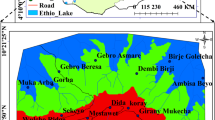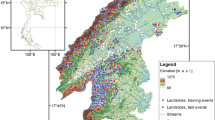Abstract








Similar content being viewed by others
References
Agterberg FP, Bonham-Carter GF, Cheng Q, Wright DF (1993) Weights of evidence modeling and weighted logistic regression for mineral potential mapping. In: Davis JC, Herzfeld UC (eds) Computers in geology, 25 years of progress. Oxford University Press, Oxford, pp 13–32
Anbalagan D (1992) Landslide hazard evaluation and zonation mapping in mountainous terrain. Eng Geol 32:269–277
Atkinson PM, Massari R (1998) Generalized linear modelling of landslide susceptibility in the Central Apennines, Italy. Comput Geosci 24(4):373–385
Bonham-Carter GF, Agterberg FP, Wright DF (1988) Integration of geological data sets for gold exploration in Nova Scotia. Photogram Eng Remote Sens 54:1585–1592
Bonham-Carter GF, Agterberg FP, Wright DF (1989) Weights of evidence modelling: a new approach to mapping mineral potential. Stat Appl Earth Sci Geol Survey Can Paper 89–9:171–183
Bonham-Carter GF (1994) Geographic information systems for geoscientists: modelling with GIS, comp. Meth. Geos., vol. 13, Pergamon, New York, p 398
Carranza EJM, Hale M (2002) Spatial association of mineral occurrences and curvilinear geological features. Math Geol 34:203–221
Çevik E, Topal T (2003) GIS-based landslide susceptibility mapping for a problematic segment of the natural gas pipeline, Hendek (Turkey). Environ Geol 44:949–962
Cheng Q (2004) Application of weights of evidence method for assessment of flowing wells in the Greater Toronto area, Canada. Nat Resour Res 13:77–86
Chung CF, Fabbri AG (1999) Probabilistic prediction models for landslide hazard mapping. Photogram Eng Remote Sens 65(12):1389–1399
Dahal RK, Hasegawa S, Yamanaka M, Nishino K (2006) Rainfall triggered flow-like landslides: understanding from southern hills of Kathmandu, Nepal and northern Shikoku, Japan. Proceedings of the 10th international congress of IAEG, The Geological Society of London, IAEG2006 Paper number 819:1–14 (CD-ROM)
Dai FC, Lee CF, Li J, Xu ZW (2001) Assessment of landslide susceptibility on the natural terrain of Lantau Island, Hong Kong. Environ Geol 40:381–391
Daneshfar B, Benn K (2002) Spatial relationships between natural seismicity and faults, southeastern Ontario and north-central New York state. Tectonophysics 353:31–44
Emmanuel J, Carranza M, Martin Hale (2000) Geologically constrained probabilistic mapping of gold potential, Baguio district, Philippines. Nat Resour Res 9:237–253
Gökceoglu C, Aksoy H (1996) Landslide susceptibility mapping of the slopes in the residual soils of the Mengen region (Turkey) by deterministic stability analyses and image processing techniques. Eng Geol 44:147–161
Gray DH, Leiser AT (1982) Biotechnical slope protection and erosion control. Van Nostrand Reinhold, New York
Greenway DR (1987) Vegetation and slope stability. In: Anderson MG, Richards KS (eds) Slope stability. Wiley, New York, pp 187–230
Guzetti F, Carrara A, Cardinali M, Reichenbach P (1999) Landslide hazard evaluation: a review of current techniques and their application in a multi-scale study, central Italy. Geomorphology 31:181–216
Harris JR, Wilkinson L, Grunsky EC (2000) Effective use and interpretation of lithogeochemical data in regional mineral exploration programs: application of geographic information systems (GIS) technology. Ore Geol Rev 16:107–143
Hasegawa S, Saito M (1991) Natural environment, topography and geology of Shikoku, Tsushi-to-Kiso. Jpn Geotech Soc 39-9(404):19–24 (In Japanese)
Hiura H, Kaibori M, Suemine A, Yokoyama S, Murai M (2005) Sediment-related disasters generated by typhoons in 2004. In: Senneset K, Flaate K, Larsen JO (eds) Landslides and avalanches, ICFL2005, Norway, pp 157–163
Lee S, Choi J (2004) Landslide susceptibility mapping using GIS and the weight-of-evidence model. Int J Geogr Inf Sci 18:789–814
Lee S, Choi J, Min K (2002) Landslide susceptibility analysis and verification using the Bayesian probability model. Environ Geol 43:120–131
Lee S, Min K (2001) Statistical analysis of landslide susceptibility at Yongin, Korea. Environ Geol 40:1095–1113
Lee S (2004) Application of likelihood ratio and logistic regression models to landslide susceptibility mapping in GIS. Environ Manage 34(2):223–232
Lee S, Talib JA (2005) Probabilistic landslide susceptibility and factor effect analysis. Environ Geol 47:982–990
Lee S (2005) Application of logistic regression model and its validation for landslide susceptibility mapping using GIS and remote sensing data. Int J Remote Sens 26(7):1477–1491
Lee S, Sambath T (2006) Landslide susceptibility mapping in the Damrei Romel area, Cambodia using frequency ratio and logistic regression models. Environ Geol 50:847–855
Okimura T, Kawatani T (1986) Mapping of the potential surface-failure sites on granite mountain slopes. In: Gardiner V (ed) International geomorphology, Part I. Wiley, New York, pp 121–138
Pachauri AK, Gupta PV, Chander R (1998) Landslide zoning in a part of the Garhwal Himalayas. Environ Geol 36:325–334
Saha AK, Gupta RP, Sarkar I, Arora MK, Csaplovics E (2005) An approach for GIS-based statistical landslide susceptibility zonation with a case study in the Himalayas, Landslides 2:61–69
Saito M, Yuuji B, Mitsunobu F (1972) Subsurface geological map of Sanbonmatsu, northeast Kagawa (scale 1:50,000), published by Economic Planning Agency, Prefecture Office, Kagawa
Siddle HJ, Jones DB, Payne HR (1991) Development of a methodology for landslip potential mapping in the Rhondda Valley In: Chandler RJ (ed) Slope stability engineering. Thomas Telford, London pp 137–142
Soeters R, Van Westen CJ (1996) Slope instability recognition, analysis and zonation. In: Turner AK, Schuster RL (eds) Landslides, investigation and mitigation, Transportation Research Board, National Research Council, Special Report 247. National Academy Press, Washington DC, pp 129–177
Styczen ME, Morgan RPC (1995) ‘Engineering properties of vegetation’. In: Morgan RPC, Rickson RJ (eds) Slope stabilisation and erosion control: a bioengineering approach. E&FN Spon, London, pp 5–58
Süzen ML, Doyuran V (2004) A comparison of the GIS based landslide susceptibility assessment methods: multivariate versus bivariate. Environ Geol 45:665–679
Tangestani MH, Moore F (2001) Porphyry copper potential mapping using the weights-of-evidence model in a GIS, northern Shahr-e-Babak, Iran. Aust J Earth Sci 48:695–701
Terlien MTJ (1996) Modelling spatial and temporal variations in rainfall-triggered landslides. PhD thesis, ITC Publ. Nr. 32, Enschede, The Netherlands, p 254
Van Westen CJ (2000) The modelling of landslide hazards using GIS. Survey Geophys 21:241–255
Van Westen CJ, Bonilla JBA (1990) Mountain hazard analysis using a PC-based GIS. In: Price DG (ed) Proceedings of the 6th international congress of IAEG, AA Balkema, Rotterdam, 1:265–271
Van Westen CJ, Rengers N, Soeters R (2003) Use of geomorphological information in indirect landslide susceptibility assessment. Nat Hazard 30:399–419
Van Westen CJ, Rengers N, Terlien MTJ, Soeters R (1997) Prediction of the occurrence of slope instability phenomena through GIS-based hazard zonation. Geol Rundsch 86:404–414
Van Westen CJ, Terlien TJ (1996) An approach towards deterministic landslide hazard analysis in GIS. A case study from Manizales (Colombia). Earth Surf Proc Landforms 21:853–868
Varnes DJ (1984) Landslide hazard zonation: a review of principles and practice, Commission on landslides of the IAEG, UNESCO, Natural Hazards No. 3, p 61
Wu W, Siddle RC (1995) A distributed slope stability model for steep forested basins. Water Resour Res 31:2097–2110
Yin KL, Yan TZ (1988) Statistical prediction model for slope instability of metamorphosed rocks. In: Proceedings of the 5th international symposium on landslides, Lausanne, 2:1269–1272
Zahiri H, Palamara DR, Flentje P, Brassington GM, Baafi E (2006) A GIS-based weights-of-evidence model for mapping cliff instabilities associated with mine subsidence. Environ Geol 51:377–386
Zêzere JL, Rodrigues ML, Reis E, Garcia R, Oliveira S, Vieira G, Ferreira AB (2004) Spatial and temporal data management for the probabilitic landslide hazard assessment considering landslide typology. In: Lacerda, Ehrlich, Fontoura and Sayâo (eds) Landslides: evaluation and stabilization, vol 1. Taylor & Fancis, London, pp 117–123
Acknowledgments
We thank Mr. Toshiaki Nishimura and Mr. Eitaro Masuda for their help in the field data collection. We also acknowledge the Kagawa Prefecture Office and Ministry of Local Development Kagawa for providing aerial photographs and data. Our thanks are due to Mr. Birendra Piya, senior geologist, Department of Mines and Geology, Government of Nepal, Kathmandu for his technical assistance and comments. We would also like to thank Dr. Netra Prakash Bhandary, Ehime University, Japan for his comments on the original manuscript. Mr. Anjan Kumar Dahal and Ms. Seiko Tsuruta are sincerely acknowledged for their technical support during the preparation of this paper.
Author information
Authors and Affiliations
Corresponding author
Rights and permissions
About this article
Cite this article
Dahal, R.K., Hasegawa, S., Nonomura, A. et al. GIS-based weights-of-evidence modelling of rainfall-induced landslides in small catchments for landslide susceptibility mapping. Environ Geol 54, 311–324 (2008). https://doi.org/10.1007/s00254-007-0818-3
Received:
Accepted:
Published:
Issue Date:
DOI: https://doi.org/10.1007/s00254-007-0818-3




